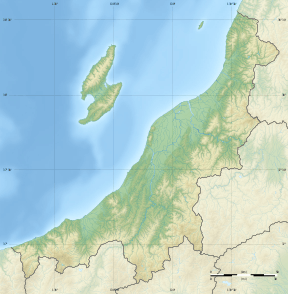Samegao Castle
| Samegao Castle 鮫ヶ尾城 | |
|---|---|
| Myōkō, Niigata Prefecture, Japan | |
 Samegao Castle 鮫ヶ尾城  Samegao Castle 鮫ヶ尾城 | |
| Coordinates | 37°3′4″N 138°13′48″E / 37.05111°N 138.23000°E |
| Type | yamashiro-style Japanese castle |
| Site information | |
| Open to the public | yes |
| Condition | ruins |
| Site history | |
| Built | c.1570s |
| Built by | Uesugi Kenshin |
| In use | Sengoku period |
| Demolished | unknown |
Samegao Castle (鮫ヶ尾城 Samegao-jō) was a Sengoku period yamashiro-style Japanese castle located in what is now part of the city of Myōkō, Niigata Prefecture in the Hokuriku region of Honshu, Japan. It has been protected by the central government as a National Historic Site since 2008.[1]
Background
Samegao castle is located on Shiroyama hill, a 180 meter hill at western edge of the Takada Plain which creates a bottleneck on the route to Shinano Province. The lower portion of Shiroyama contains the Hida Site, the ruins of a Jomon period fortified settlement, which indicates that the location was seen as a strategically important place for over 1800 years,
After the Fourth Battle of Kawanakajima in 1560, Takeda Shingen seized most of Shinano Province. Shingen's arch-rival, Uesugi Kenshin had his capital at Kasugayama Castle in what is now the city of Joetsu, only 50 kilometers from the border with Shinano. With few natural obstacles standing between Kasugayama Castle and the border, the Uesugi clan quickly fortified the border area and its remaining holdings in Shinano (i.e. Iiyama Castle) against a sudden invasion by Takeda forces.
Structure
Samegao Castle was one of the relatively large castles in for area, extending over 300 meters across the hilltop, and consisted of three main areas. The inner bailey consisted of several terraces approximately 50 meters long, protected on its north edge by steep dry moats. The entrance was to the east, which was a kuruwa with dry moats and terraces intermittently extending along a long ridge. South of the inner bailey was the third area, with smaller terraces built up the steep hill in steps, and formed the rear of the castle.
History
Although built primarily to guard against the Takeda clan, Samegao Castle was more deeply connected with the inner struggle of the Uesugi clan following the death of Uesugi Kenshin. Kenshin had two adopted sons, Uesugi Kagekatsu and Uesugi Kagetora, but died without appointing a successor. The clan quickly fell into civil war, with Kagektasu seizing Kasugayama Castle and making a peace treaty with the Takeda clan. On the other hand, Kagetora was strongly backed by the Hōjō clan. In April 1579, Kagekatsu made all-out attack on Kagetora's headquarters at Ōtate. Kagetora was defeated, and escaped to Samegao Castle, where he committed suicide.[2] The castle appears to have been abandoned shortly after this time. After Oda Nobunaga destroyed the Takeda clan in 1582 and occupied Shinano Province, his forces threatened the Uesugi clan in Echigo, but there is no evidence that Samegao Castle had been rebuilt by that time.
During modern archaeological excavations, traces of burnt buildings and carbonized rice ball was excavated, and they show the fierce battle of this time.